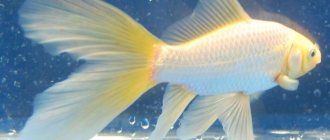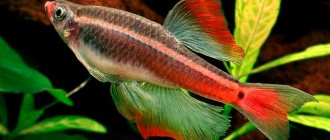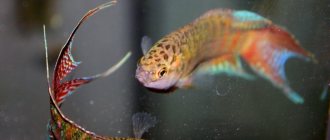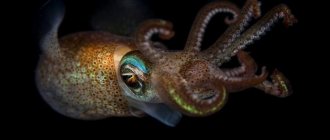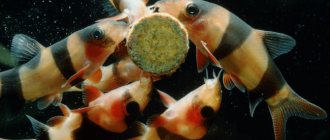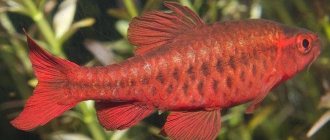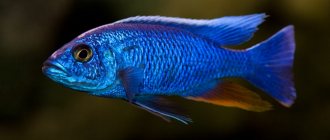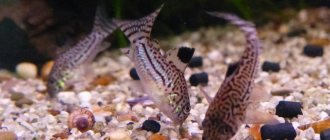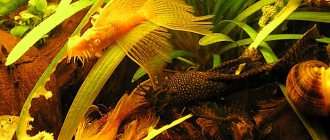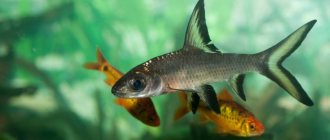The Aquarium Goldfish is an artificially bred freshwater species belonging to the genus of crucian carp and the class of rayfins. It has a laterally compressed or short rounded body. All species have pharyngeal teeth, large gill roofs, and hard barbs that form fins. The scales can be both large and small - it all depends on the species.
The color can be very different - from golden to black with various inclusions. The only common feature is that the belly shade is always a little lighter. It’s easy to convince yourself of this by looking at photos of goldfish. The size and shape of the fins also vary greatly - long, short, forked, veil-shaped, etc. In some species, the eyes are bulging.
The length of the fish does not exceed 16 cm. But in large tanks they can reach 40 cm, not including the tail. The lifespan directly depends on the form. Short, round fish live no longer than 15 years, and long and flat fish live up to 40.
The history of goldfish
The aquarium goldfish is a direct descendant of the crucian carp. It appeared more than 1,500 years ago as a result of random genetic connections. Initially, fish were the privilege of only wealthy Chinese. Fish appeared in Russia in the 18th century.
Over the 2000s, thousands of years of history, breeders have developed many varieties of aquarium goldfish.
Habitat
The goldfish we know today are the result of crossbreeding with goldfish, so they are not found in natural habitats.
These fish are a type of crucian carp that was artificially bred in China from silver crucian carp. The first mentions of it can be found in Chinese chronicles. The natural habitat of this species is the rivers of the southern Chinese provinces.
habitat of silver crucian carp
Silver crucian carp, which is the ancestor of all goldfish, was first distributed in the lower reaches of the rivers of the Aral Sea, reservoirs of Central Asia and Siberia. Later it was artificially resettled in many reservoirs in Europe and Siberia. At the beginning of the 16th century, goldfish were exported to Japan and China, where the fish served as a living decoration for the imperial gardens.
It is interesting that in some reservoirs only female goldfish lived, which crossed with males of related fish species (golden carp, roach, tench, carp, bream and others). Spermatozoa of related species stimulated the development of eggs, but no hybrids were formed. Only females were born that supported the existing population.
The original form of a goldfish
Goldfish and silverfish have many similar external characteristics. In some reservoirs they live together. Golden crucian carp is gradually replacing silver carp, plus they produce hybrids that can be found in some reservoirs.
Interestingly, in Australia, amateur aquarists released goldfish into natural reservoirs, where they grew to significant sizes. The largest representative weighed 1.9 kg.
It is worth saying that goldfish pose a serious threat to other inhabitants of the reservoir, because... They are quite voracious, eat plants, eggs of other fish, and become spreaders of infectious diseases.
Types of goldfish
A variety of shapes and colors allows you to choose a pet to suit your taste. Goldfish are divided into two types: short-bodied and long-bodied. But type is one thing, but breed is another. Below is a description of popular breeds of aquarium goldfish.
Heavenly eye or astrologer
A beautiful, large animal with a round shape. Body length is up to 15 cm. A special feature of this breed is its telescopic eyes. The color of the stargazer is orange with a golden touch.
Water eyes
The size of this beauty reaches 20 cm. The most common fish are silver, orange and brown.
Veiltail or Fantail
Nature has awarded the veiltail with rich colors: from gold to red and black. Its tail is impressively beautiful. It spreads out in soft waves, falling like a beautiful veil.
Pearl
The pearl was bred in China. It has scales that resemble pearls.
Comet
This beauty has an elongated body. The tail is forked, and the longer it is, the more highly valued the specimen is. The comet is similar to the veiltail, and therefore they are often confused by inexperienced aquarists.
Oranda
A distinctive feature of the Oranda from other breeds is the cap on its head. In all other respects it is similar to the veiltail.
Ranchu
Ranchu appeared thanks to Japanese breeders.
Shubunkin
Another cute Japanese guy. In its homeland it is called calico or sibunkin, but in Russia the name “calico” has stuck. The calico goldfish got its name due to its unusual color. This is a large breed that is kept in bodies of water, such as greenhouse ponds. Not suitable for home keeping due to its size. But, if you want, you will have to purchase a spacious aquarium.
Telescope
Very similar to a stargazer with large, bulging eyes. Grows no more than 12 cm.
Lionhead
The lion head got its name for a reason. At the age of 3 months, growths appear on the head that frame it like a mane.
Lifespan
The lifespan of goldfish is most dependent on the number of individuals living in one aquarium, as well as on the quality and temperature of the water.
Studies have shown that small fish live up to 5 years, medium ones - from 10 years, and large ones - up to 30. Females die earlier than males.
The record holder for the longest life in an aquarium is a fish that lived for 44 years. The body length of individuals raised in captivity is usually no more than 20 centimeters.
Goldfish are best suited for aquarists and as pets: they are easy to care for, compatible with many other fish species, and easy to breed. An individual may die without regular care, so do not neglect changing water or feeding. Aquarium fish are inexpensive.
Goldfish are sociable: they can take food from hands or swim into an open palm if they trust the owner.
How to choose an aquarium for goldfish?
To choose the right aquarium, you need to take into account only 2 parameters: shape and volume.
Aquarium volume
The volume of the aquarium must correspond to the number of residents. For the comfort of residents, aquarium cubic meters must correspond to the following dimensions: 80 liters per individual. For two pets you need 100 liters. It is necessary to take into account the fact that design additions, in the form of plants, houses, as well as various filters, steal useful volume. Soviet textbooks on aquarium keeping allowed for much smaller sizes, but the fish were also of Soviet origin. They were genetically adapted to such a living area. Nowadays goldfish are brought from China, Japan, and Malaysia, the care and maintenance of which are completely different. Many novice aquarists, not knowing these subtleties, are faced with the death of their pets, blaming the sellers. In fact, the owner is to blame for not adapting the new resident to other volumes. You should not point your head at exhibition aquariums in which the fish live crowded together, like in a multi-story building. There are powerful filters and aerators, the water is changed 24/7, and there is always an ichthyopathologist nearby who monitors their health. It is almost impossible to provide such care at home.
Aquarium shape
There is only one rule here: the aquarium must be rectangular, the length is 2 times the width. Square, too tall and narrow aquariums are not suitable. Very slight curvature is allowed and only for the viewing glass. The side and rear windows must be strictly straight. Round, cylindrical and glasses are not suitable for keeping goldfish. The fact is that the fish's mental health begins to suffer. No matter how absurd this may seem, it is a fact.
Feeding
It is not difficult to choose a diet for goldfish, since this species is omnivorous.
The following products can be used:
- Multi-component dry ready-made food for fish.
- Any live food, for example, bloodworms, daphnia, earthworms. It is desirable that the protein content is high.
- Aquatic plants and algae - duckweed, vallisneria, riccia, hornwort.
- Herbs such as nettle, green salad, dandelion. It must be given finely chopped.
- Vegetables - pumpkin, carrots, zucchini, cucumber. They should be grated on a fine grater.
Additional, non-daily complementary foods can also include:
- Porridge - buckwheat or millet. Definitely no salt, sugar or oil.
- Sea fish and seafood. They need to be finely chopped.
- Spirulina.
- Bread crumbs.
Water requirements
Water requirements are strict, especially regarding temperature. The temperature ranges from 20° to 23°. For young animals or breeds with a round body, the water should be warmer, approximately 24-25°. Acid-base balance, pH, about 7. Hardness not less than 8°.
The water must sit for at least 24 hours. During settling, a large number of impurities and heavy fractions settle out, and chlorine evaporates. If you had to pour water straight from the tap, then you need to use a water stabilizer. You can purchase it in specialized aquarium stores or pet stores. The water in the aquarium must be constantly filtered. To do this, you need a multi-section filter, which must work around the clock. The power of the device is at least 3 - 4 l/h. The filter must be cleaned weekly. Rinse with aquarium water so as not to destroy the colony of bacteria living in the ceramic compartment.
It is necessary to constantly change the water. This is the name given to partial water replacement and topping it up to normal levels. This should also be done once a week, and if there are many inhabitants, then more often.
In addition to filtration, the water must be constantly aerated. Many filters are equipped with aerators, but it is better to purchase an additional compressor.
Description
The shade of goldfish scales can vary. There are traditional red-golden, black with a blue tint, greenish-bronze and other individuals. They all have one common characteristic: the abdomen is much lighter than the color of the upper body.
They are divided into two groups:
- long-bodied;
- short-bodied.
The first group includes traditional goldfish, comets and wackines. They originate from silver crucian carp and have a body shape similar to it. Fish of this group can live up to 40 years, which makes them the undisputed leaders in longevity among other subtypes. Shubunkins are also among the hardiest goldfish.
The second group is distinguished by a noticeably compressed body. This is due to the experiments of breeders. The brightest representatives are the telescope and the pearl. Fish of this subtype are quite sensitive and react sensitively to the slightest changes in their contents. Such specimens rarely live longer than 15 years, but even this period is relatively long.
China is the leader in the number of species bred. There are almost 350 varieties in the Middle Kingdom . Among Chinese breeders there is a different classification.
- Long-bodied species - “Se”.
- Individuals with growths or unusual fins are called “Ven”.
- Fish with unusually large and bulging visual organs - “Dragon Eye”.
- Instances with an ovoid body - “Egg”.
The average length is no more than 15 cm. But in a number of cases, breeders managed to raise individuals up to 47 cm in length.
Soil and plants
Goldfish love to dig in the ground. It is better to choose either a very large fraction or a very small one. This is necessary so that they do not choke on grains of sand. It is also necessary to pay attention to the shape of the grains of sand. They should be smooth, without sharp edges or corners. Plants for an aquarium with goldfish are a must. Their role is the same as on land: maintaining ecological balance. In addition, plants for goldfish are vitamin supplements. They chew them with great pleasure. It is better to plant plants in pots. The fact is that the “golden girls” mercilessly undermine them. Plants are changed as necessary.
As for the decor that aquarium owners love to install, they are not needed for golden beauties. Goldfish do not use aquarium shelters. But they can get hurt on all sorts of locks and chests, especially their fins and tails. It’s very disappointing for the owners of “pearls”: having lost a pearl scale, the pet will restore it, but the previous, beautiful rim will no longer be there. So the best decor will be only plants.
Behavior
The behavior of goldfish varies depending on the characteristics of the environment, and in an aquarium, on the preferences of the aquarist. Pets have developed associative memory, and they clearly identify their breadwinner. The owner may notice that the pets react to his approach (swim up to the front glass, quickly move around the aquarium, rise to the surface in anticipation of food), but hide when strangers approach.
Goldfish nutrition
It is enough to feed your pets 2 times a day. It’s not worth it more often, otherwise these voracious creatures will begin to suffer from overfeeding. Once a week you can and should have a fasting day. The amount of food is calculated empirically, but it has been noted that you need to give as much as will be eaten within 5 minutes. The diet uses dry food, which is soaked in aquarium water for 20-30 seconds. Dry food is alternated with natural plant foods. The fish will like: spinach, lettuce, boiled vegetables, fruits. Delicacy for pets: boiled cereals, meat and liver. For variety, give bloodworms and daphnia. If the bloodworm is frozen, then first defrost it. But they grow daphnia at home on their own.
Care of offspring
Spawning usually begins in the morning and lasts several hours. When it ends, the fish are returned to their original aquarium, and the water in the spawning tank is reduced. Caviar can be transferred to smaller containers. Whitish and cloudy unfertilized eggs should be disposed of immediately, as they pollute the water. Snails can also cope with this task perfectly.
The caviar should be well lit, but it should not be overheated. Containers should not be placed in direct sunlight. The fry hatch in 3-4 days. They are given live dust as food. As they grow, young specimens are separated by size into different aquariums, otherwise the larger specimens will eat the smaller ones.
Breeding goldfish
As soon as the first goldfish appears in the house, the temptation arises to buy several more. If we are talking exclusively about golden pets, then it is clear that there should be only one breed in the aquarium. They are all related to each other, so there is a risk of getting “mongrels”. With such careless species and type maintenance, after a while ordinary crucian carp will swim in the aquarium.
The optimal age suitable for breeding is 2 – 3 years.
To breed goldfish, you need a separate spawning aquarium, in which a male and two females are placed. After spawning, adults are returned to the main aquarium.
The fry will appear in a week. At first, babies feed on the reserves of the yolk sac, and then switch to independent feeding.
Reproduction (spawning)
Fish become sexually mature at the age of one year, but begin to reproduce only at two years of age. In the spring, the mating season begins, the males become smart, with white spots on the gills, and the females have an enlarged belly.
Before spawning, the female and a pair of males are transplanted into a previously prepared spawning ground with an abundance of plants and no soil. The lighting should be bright, and the water level in the aquarium should not exceed 20 cm.
To prevent the parents from eating the eggs, a coarse mesh is placed approximately 2-3 cm from the bottom. During one spawning period, the female spawns up to 10 thousand eggs. After the end of spawning, the parents are removed.
The larvae appear on the 2nd–6th day, this depends on lighting, temperature and water aeration. For the first day, the fry feed from the yolk sac, then they begin to eat on their own. They are fed:
- rotifer;
- plankton;
- crustaceans;
- ready-made food for fry.
As they grow and develop, selection is carried out: large babies are separated from smaller ones in order to avoid cannibalism.
With careful attention to the inhabitants of the aquarium, proper care and a balanced diet, goldfish will delight the owner for many years.

